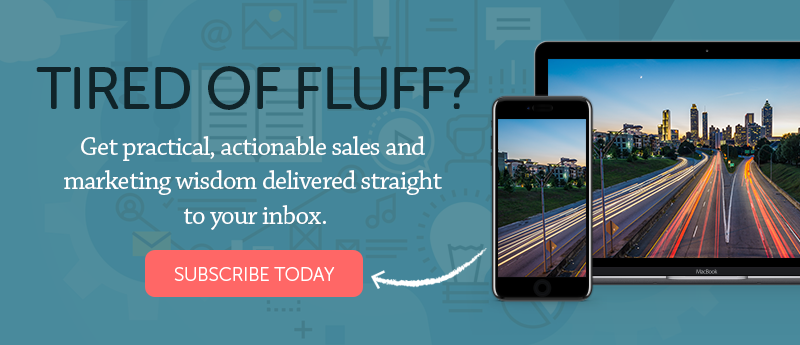
You sell better when you stop selling.
That seems backwards, but what may have worked for you in the past isn’t necessarily going to work in an age of digital marketing...and digital selling.
And the big reason for this? Customers are different today. They interact with businesses and brands differently, their values have changed, and their decision-making processes have become more empowered. Simply put, they don’t buy products and services the way they used to, so if you’re trying to use your old sales methods on modern customers, you can expect to encounter some hurdles.
Your customers have changed...how can you keep up?
Consumer Behavior In Digital Marketing
In the past, customers needed salespeople to help them decide what and when to buy. You were their research channel, their trusted advisor, and their support system. Now, potential customers can do their own research online.
However, you can't exactly take the same old tactics you've been using and digitize them. For instance, getting in front of the customer is a feat in and of itself, let alone keeping their attention once you have it. To make matters worse for salespeople, 2015 saw a mass adoption of ad-blocking software. Customers don’t always want to see ads, and they’re careful and deliberate about what they click on. They've also become adept at dodging unproductive sales content, cutting through the BS, and finding the exact information they're looking for.
The buyer’s journey of a modern customer is so different than it was in the past that, now, by the time they choose to interact directly with your brand, they’re already 80% of the way through that journey.
Not only are modern potential customers more informed and more convicted, they also don’t like being “sold to.”
This where inbound sales comes in.
What Is Inbound Sales?
Inbound sales is basically what happens when your sales and marketing departments marry. This feels more natural for customers; selling becomes a part of the marketing experience. The marketing content should dovetail so seamlessly into the sales experience that the customer doesn't even realize they're being sold to.
Inbound sales also means that you see the customers' pain points as more important than your sales goals. It's about solving a problem they're already experiencing - not convincing them of a false need.
To put this into perspective, think about a patient seeing a doctor. The patient has a problem that they need addressed thoroughly, directly, and with care. The patient knows the doctor is the expert in the field, so the doctor's opinions, diagnoses, and recommendations are taken as gospel. Years of education and experience went into those recommendations, so the doctor is seen as a trusted advisor with the patient's best interest in mind. A patient will rarely question a doctor they're comfortable with.
...See where I'm going with this?
In today’s digital sales and marketing world, your customer is the patient with a problem that they need solved. You are the trusted, experienced, and concerned doctor with the prescription.
Inbound sales strategies work Harder than you do
HubSpot created a chart that makes it easy to compare the differences between inbound and outbound sales, but generally speaking, you can see the differences in the salesperson's approach to the process.
- An inbound sales strategy tells you who is actively seeking your product or service. On the other hand, an outbound sales approach doesn’t discern which buyers are active in the cycle. Everyone is a generic target.
- Inbound sales strategies are personalized and can be adapted to suit the customer's unique needs and requirements. Conversely, an outbound sales approach uses generic presentations to both pitch to and entice potential customers.
- Inbound sales strategies fit the customer' timelines more naturally. An outbound sales approach uses standard discounts to entice buyers, but ultimately works at the seller’s convenience.
But a major point in the inbound versus outbound sales/marketing debate is this: outbound sales stops working when you do.
Outbound sales requires constant pressure; constant action.
But inbound sales keeps going even as your activity level fluctuates. These strategies are designed to generate and sustain passive sales momentum in a way that outbound strategies can't. Since inbound strategies focus on automation, personalization, and aligning with the customer wherever they are in their buyer's journey, they're still working whether you're actively prospecting and selling, or not.
But don't think you can sit back and watch the dough roll in. Inbound sales, while more laid-back, is still mindful work. Strategy and setup are both important.
Inbound Sales Methodology
In a nutshell, the inbound sales methodology aims to educate potential leads through a process of nurturing leads in the inbound sales funnel.
And of course, the goal with anything inbound is for people to be able to find you when they're looking for solutions you offer.
The education you're providing should be targeted and purposeful. It should speak directly to the customer, wherever they are in their buyer's journey. In fact, it's a bit of an art form, in terms of designing a structure with the appropriate branches, language and messaging, and flow to encourage engagement and endorsement from your leads. The key to lead nurturing, then, is that you want the customer to feel comfortable and eased through the digital sales process, not reluctantly dragged through it.
After all, it's about them.
For you, this means that if you can’t offer anything new and valuable that directly addresses your prospect's concern, he or she will never come looking for you. It's not like a customer browsing in a store who you can sometimes convince to buy something. They're just not going into your store.
The buyer’s journey, in simple form, looks like this:
- Awareness Stage: The buyer becomes aware of a need or desire.
- Consideration Stage: The buyer has a goal or has defined the challenge, and has committed to meeting it.
- Decision Stage: The buyer decides on a solution that meets their needs.
With a good lead nurturing campaign, you should be able to target potential customers who have shown an interest in your product or service early in the buyer’s journey. You want to deliver the goods they need before they even ask for them by anticipating their thought processes.
And don't worry about pushing too much info or content on them. If you get it right, they're already looking for it.
Sales and Marketing Integration
Sales and marketing need to work together. There's no way around it anymore. Marketing is already tracking what blogs your customers are reading, and what they're interested in or engaging with on social media. Not only that, they’re creating content to attract those customers to the website and into your sales funnel.
In other words, marketing has already been identifying customers and leading them through the buyer’s journey. Sales needs to be there alongside marketing because the sale is no longer just an endpoint - it's a process. Marketing doesn’t necessarily hand off a customer for the sale. The sale happens as the potential buyer continues to consume and value information that marketing is providing.
For the sales team, this means they've got to be accessible to customers as they inquire about the product or service, and as they fall further down the sales funnel. But there's no hard selling that happens at any point. Remember the doctor-patient relationship we talked about earlier? This is where it really comes into play. The customer wants an expert opinion and insight, and they want to know that the purchase they're considering is in their own best interest.
During any given interaction the customer has with the brand, whether it's with the sales or marketing team, the messaging has to be consistent and supportive. Both teams must be on the same page for this to be effective, smooth, and less confusing for the customer.
Happier Customers with Inbound Sales
The inbound sales methodology still has the same endgame as traditional outbound sales. You're still trying to bring revenue into your business. But outbound sales relies on old-school tactics that simply don't offer the same returns as they once did. Inbound, on the other hand, is efficient and effective when dealing with modern buyers, as it operates under the assumption that people will buy when they’re ready to.
What does that mean for you? Your sales team won’t waste time pursuing "leads" that are bad fits for business. Customers won’t feel that dreaded pressure to buy, which isn't a good time for anyone. The customers that do buy will see greater value in their purchase because, through the inbound sales process, they've been educated enough on the product or service to make an informed decision, i.e., there's less of a chance for buyer's remorse.
Remember, in the digital age, customers have the power to disengage. But if your sales team can work well with the marketing team, you should be able to deliver a valuable message, hold their interest, close a sale, and create a lifetime customer.

